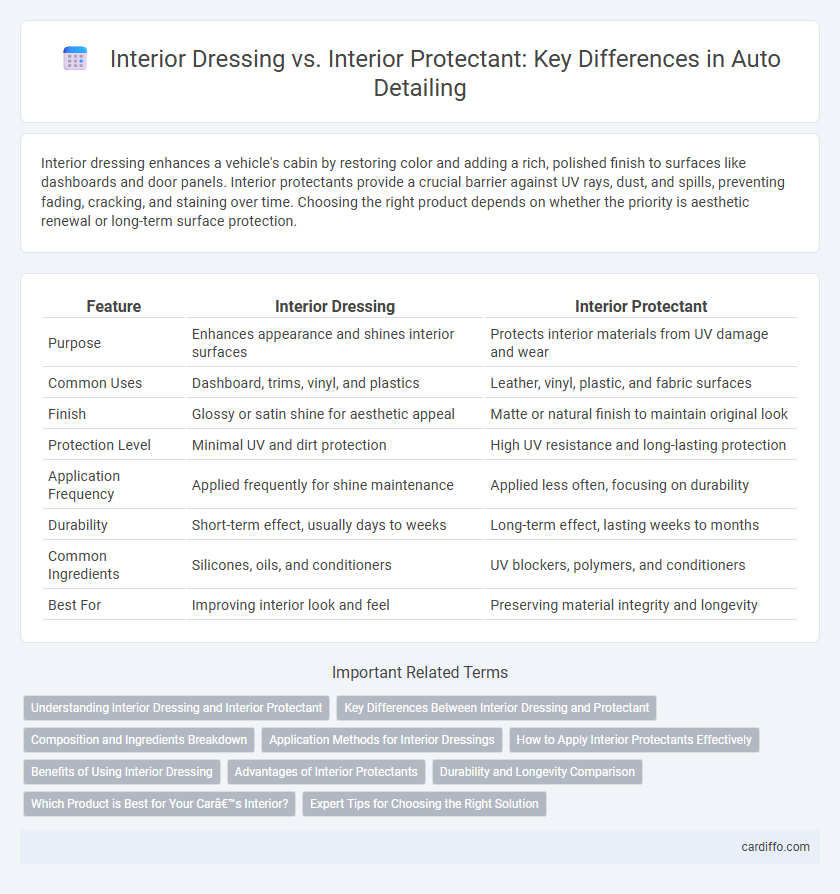Interior dressing enhances a vehicle's cabin by restoring color and adding a rich, polished finish to surfaces like dashboards and door panels. Interior protectants provide a crucial barrier against UV rays, dust, and spills, preventing fading, cracking, and staining over time. Choosing the right product depends on whether the priority is aesthetic renewal or long-term surface protection.
Table of Comparison
| Feature | Interior Dressing | Interior Protectant |
|---|---|---|
| Purpose | Enhances appearance and shines interior surfaces | Protects interior materials from UV damage and wear |
| Common Uses | Dashboard, trims, vinyl, and plastics | Leather, vinyl, plastic, and fabric surfaces |
| Finish | Glossy or satin shine for aesthetic appeal | Matte or natural finish to maintain original look |
| Protection Level | Minimal UV and dirt protection | High UV resistance and long-lasting protection |
| Application Frequency | Applied frequently for shine maintenance | Applied less often, focusing on durability |
| Durability | Short-term effect, usually days to weeks | Long-term effect, lasting weeks to months |
| Common Ingredients | Silicones, oils, and conditioners | UV blockers, polymers, and conditioners |
| Best For | Improving interior look and feel | Preserving material integrity and longevity |
Understanding Interior Dressing and Interior Protectant
Interior dressing enhances vehicle interiors by restoring and enriching surfaces such as dashboards, door panels, and leather seats, providing a fresh, well-maintained appearance. Interior protectants create a protective barrier that shields materials from UV rays, stains, and wear, extending the lifespan of plastics, vinyl, and leather. Both products are essential in automotive detailing for maintaining aesthetic appeal while preserving the durability of interior components.
Key Differences Between Interior Dressing and Protectant
Interior dressing primarily enhances the appearance of surfaces such as dashboards, door panels, and trim by providing a rich, glossy finish that revitalizes and restores color. Interior protectant, on the other hand, focuses on safeguarding interior materials from UV damage, fading, cracking, and wear through the application of specialized coatings that maintain durability and cleanliness. Key differences include their main functions--dressing emphasizes aesthetics and shine, while protectant emphasizes preservation and long-term protection of interior surfaces.
Composition and Ingredients Breakdown
Interior dressing typically contains a blend of silicone oils, polymers, and UV inhibitors designed to restore shine and provide a flexible, non-greasy finish on surfaces like vinyl, plastic, and leather. Interior protectants often include advanced anti-oxidants, UV blockers, and hydrophobic agents aimed at preventing fading, cracking, and degradation caused by sun exposure and environmental contaminants. Both formulations prioritize durability and surface compatibility, but dressings emphasize cosmetic enhancement while protectants focus on long-term preservation.
Application Methods for Interior Dressings
Interior dressings are typically applied using microfiber applicator pads or foam applicators to ensure even coverage and reduce waste, while interior protectants often come in spray forms allowing for quick and consistent application. Proper surface preparation, such as cleaning and drying, is crucial before applying dressings to maximize adhesion and longevity. Layering dressings in thin coats enhances the finish and prevents buildup, contrasting with protectants which are designed for a single, uniform protective layer.
How to Apply Interior Protectants Effectively
Applying interior protectants effectively requires thorough surface preparation by cleaning and drying all areas to ensure optimal adhesion and durability. Use a microfiber applicator pad or cloth to evenly distribute the product in thin layers, paying close attention to commonly handled surfaces like dashboards, door panels, and center consoles. Regular reapplication every 30 to 45 days helps maintain UV protection and prevents cracking, fading, and premature wear on interior materials.
Benefits of Using Interior Dressing
Interior dressing enhances vehicle interiors by restoring original color and providing a rich, polished finish that resists fading and cracking. It conditions surfaces such as vinyl, leather, and plastic, preventing premature wear and maintaining a like-new appearance. Regular application also repels dust and dirt, reducing cleaning frequency and preserving the overall aesthetic appeal.
Advantages of Interior Protectants
Interior protectants form a crucial barrier against UV rays, preventing fading and cracking of surfaces such as leather, vinyl, and plastic. Unlike interior dressings that primarily enhance appearance, protectants extend the longevity of materials by repelling dust, dirt, and spills, reducing the need for frequent cleaning. Their advanced formulations ensure surfaces remain flexible and hydrated, maintaining a factory-new look while guarding against environmental damage.
Durability and Longevity Comparison
Interior dressing products primarily enhance the visual appeal of surfaces by restoring color and adding a fresh, polished look, but their durability typically lasts only a few weeks under regular use. Interior protectants form a more resilient barrier against UV rays, spills, and general wear, significantly extending the lifespan of treated surfaces up to several months. Choosing a quality interior protectant ensures long-term preservation and reduces the frequency of reapplication compared to standard interior dressings.
Which Product is Best for Your Car’s Interior?
Interior dressing enhances your car's interior by restoring color and providing a rich, polished finish to surfaces like dashboards and door panels, while interior protectants primarily create a barrier against UV damage, stains, and dust accumulation. Choosing the best product depends on your goal: use interior dressing for aesthetic improvement and shine, and select an interior protectant for long-lasting preservation and defense against fading or cracking. Regular application of both can maintain a balance between style and durability, ensuring your car's interior remains vibrant and well-protected.
Expert Tips for Choosing the Right Solution
Interior dressing enhances the vehicle's appearance by restoring shine and deepening the color of surfaces such as dashboards, door panels, and trim. Interior protectant focuses on creating a barrier against UV rays, dust, and spills to prevent cracking and fading over time. Expert tips emphasize selecting products based on surface type and desired durability, opting for water-based dressings on vinyl and leather protectants for natural materials to ensure long-lasting protection and aesthetic appeal.
Interior dressing vs Interior protectant Infographic

 cardiffo.com
cardiffo.com